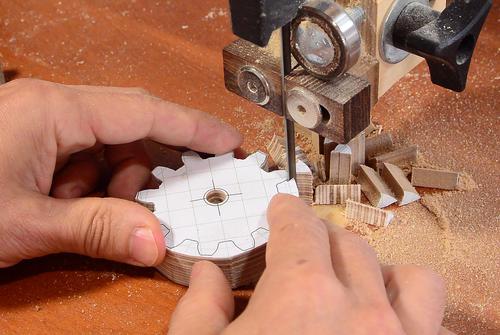 I have used wooden gears for various projects over the years, but other than my
baby soothing machine, never for real
power transmission. So figured I'd make a test set-up to run some gears until
they wear out.
I have used wooden gears for various projects over the years, but other than my
baby soothing machine, never for real
power transmission. So figured I'd make a test set-up to run some gears until
they wear out.
 I have used wooden gears for various projects over the years, but other than my
baby soothing machine, never for real
power transmission. So figured I'd make a test set-up to run some gears until
they wear out.
I have used wooden gears for various projects over the years, but other than my
baby soothing machine, never for real
power transmission. So figured I'd make a test set-up to run some gears until
they wear out.
I printed out some gear templates with my gear generator and cut them out on the bandsaw.
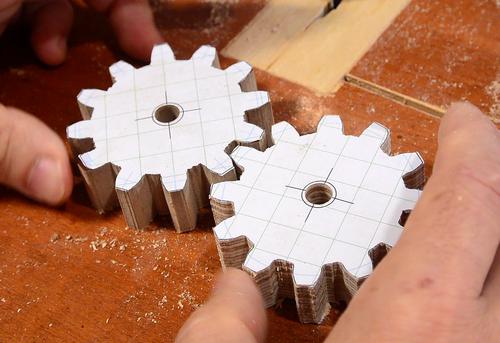 I made two gears the same size, one out of Baltic birch (which I
consider the best material for gears) and the other out of MDF, because I'm
often asked about the suitability of MDF for gears.
I made two gears the same size, one out of Baltic birch (which I
consider the best material for gears) and the other out of MDF, because I'm
often asked about the suitability of MDF for gears.
It would have been preferable to make one gear with one tooth more than the other so it wouldn't always mesh the same teeth together, but I wanted the gears to be equal so I could see which material wore out first.
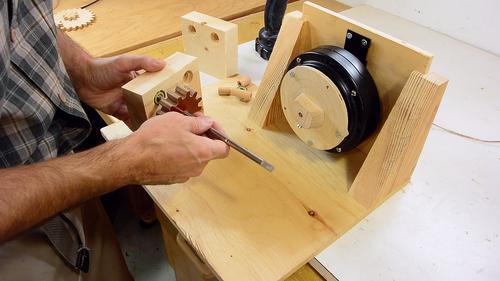 Hand cut wooden gears never run totally smooth, so I needed a relatively
low speed motor to drive this with. I also wanted a motor that was long
lasting and quiet. A ceiling fan motor fit the bill. The one I used is
a 16-pole motor with a no load speed of 450 RPM. But ceiling fan motors
have an outside that rotates around a fixed shaft, so I had to mount it
by its shaft and make a flange to mount a shaft to the spinning outside.
Hand cut wooden gears never run totally smooth, so I needed a relatively
low speed motor to drive this with. I also wanted a motor that was long
lasting and quiet. A ceiling fan motor fit the bill. The one I used is
a 16-pole motor with a no load speed of 450 RPM. But ceiling fan motors
have an outside that rotates around a fixed shaft, so I had to mount it
by its shaft and make a flange to mount a shaft to the spinning outside.
"Why not just mount the outside and let the shaft spin?" But all the electrical wires come through the shaft. The motor's stator, windings and all, is on the inside not the outside.
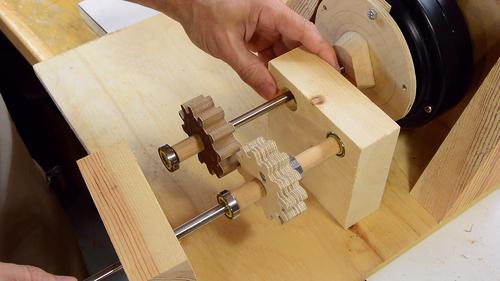 I used some 8 mm steel shafting and roller skate bearings,
with wooden spacers in between the gears and bearings to keep things
spaced right. The MDF gear fits very tight on the shaft, the other
gear is screwed to a small wheel that the shaft came with.
I used some 8 mm steel shafting and roller skate bearings,
with wooden spacers in between the gears and bearings to keep things
spaced right. The MDF gear fits very tight on the shaft, the other
gear is screwed to a small wheel that the shaft came with.
The bearings fit in holes in wooden blocks to hold them in place.
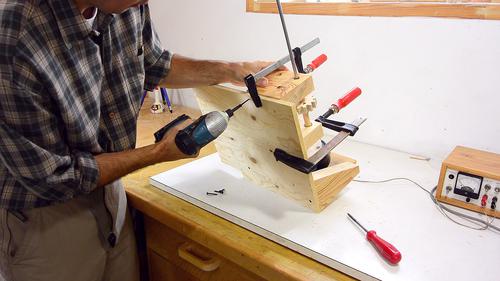 After aligning everything, I clamped the wooden blocks down, tested it,
then screwed the blocks on from below.
After aligning everything, I clamped the wooden blocks down, tested it,
then screwed the blocks on from below.
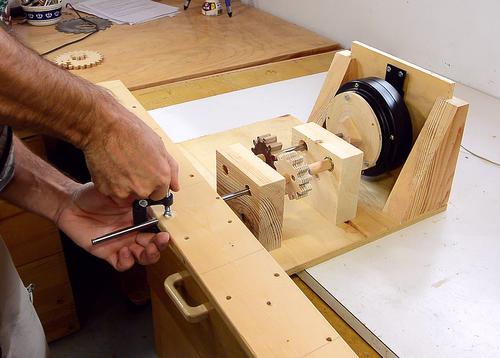
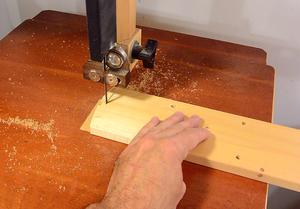 I made a spinning paddle to go on the shaft to act as a "load". But this paddle
had more air resistance than the original ceiling fan blades, so I had to shorten it
a few times until the motor ran at a reasonable speed.
I made a spinning paddle to go on the shaft to act as a "load". But this paddle
had more air resistance than the original ceiling fan blades, so I had to shorten it
a few times until the motor ran at a reasonable speed.
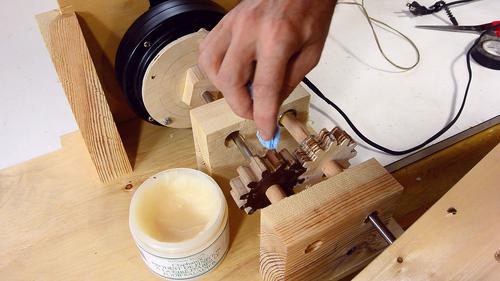
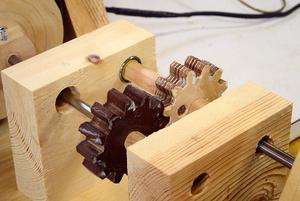 I figured if gears are meant to be used under load for a long time, lubricating
them would make a lot of sense. I used "salad bowl finish" consisting of
linseed oil and beeswax. It wasn't meant as a lubricant, but it's a lot less
"dirty" than axle grease.
I figured if gears are meant to be used under load for a long time, lubricating
them would make a lot of sense. I used "salad bowl finish" consisting of
linseed oil and beeswax. It wasn't meant as a lubricant, but it's a lot less
"dirty" than axle grease.
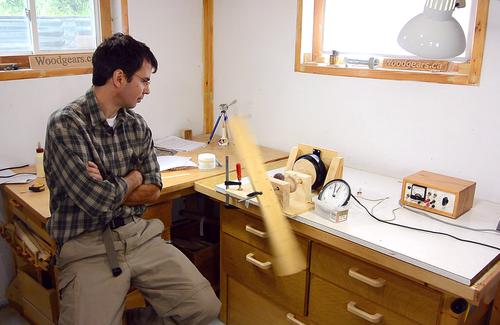 Then running the gears while keeping an eye on the clock. But after half an hour,
I couldn't really see much in the way of wear.
Then running the gears while keeping an eye on the clock. But after half an hour,
I couldn't really see much in the way of wear.
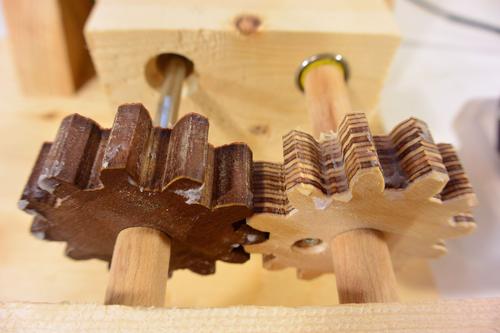 So I kept the set-up running for six hours. After that, the gear still didn't look worn.
So I kept the set-up running for six hours. After that, the gear still didn't look worn.
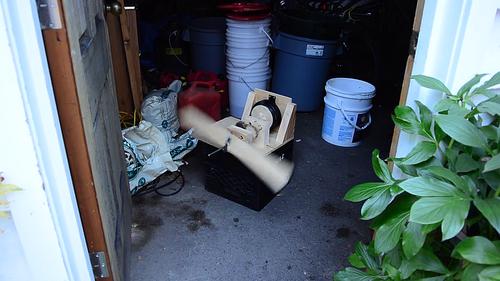 I wanted to get it off my workbench, so I put it in my garage and let it run for
another 24 hours.
I wanted to get it off my workbench, so I put it in my garage and let it run for
another 24 hours.
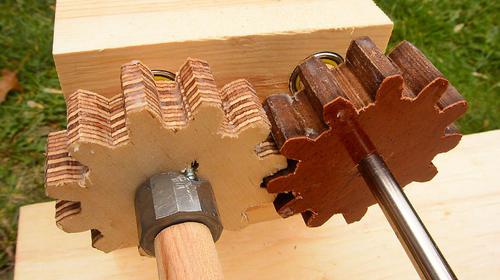 After that, still no appreciable sign of wear.
After that, still no appreciable sign of wear.
Given the state of wear, they'd have to run for more than a week before I'd see much in the way of wear.
I have been asked a few times how long I think the gears on my box joint jig would last. I have never seen any sign of wear on mine, now I'm quite sure they will last a very long time, even if made from MDF.
I now figure wooden gears would be fine for power transmission on some wooden woodworking machine, so long as it's a low speed application. But wooden gears wouldn't be suitable for taking power straight off an induction motor, even a slower 1750 RPM motor.